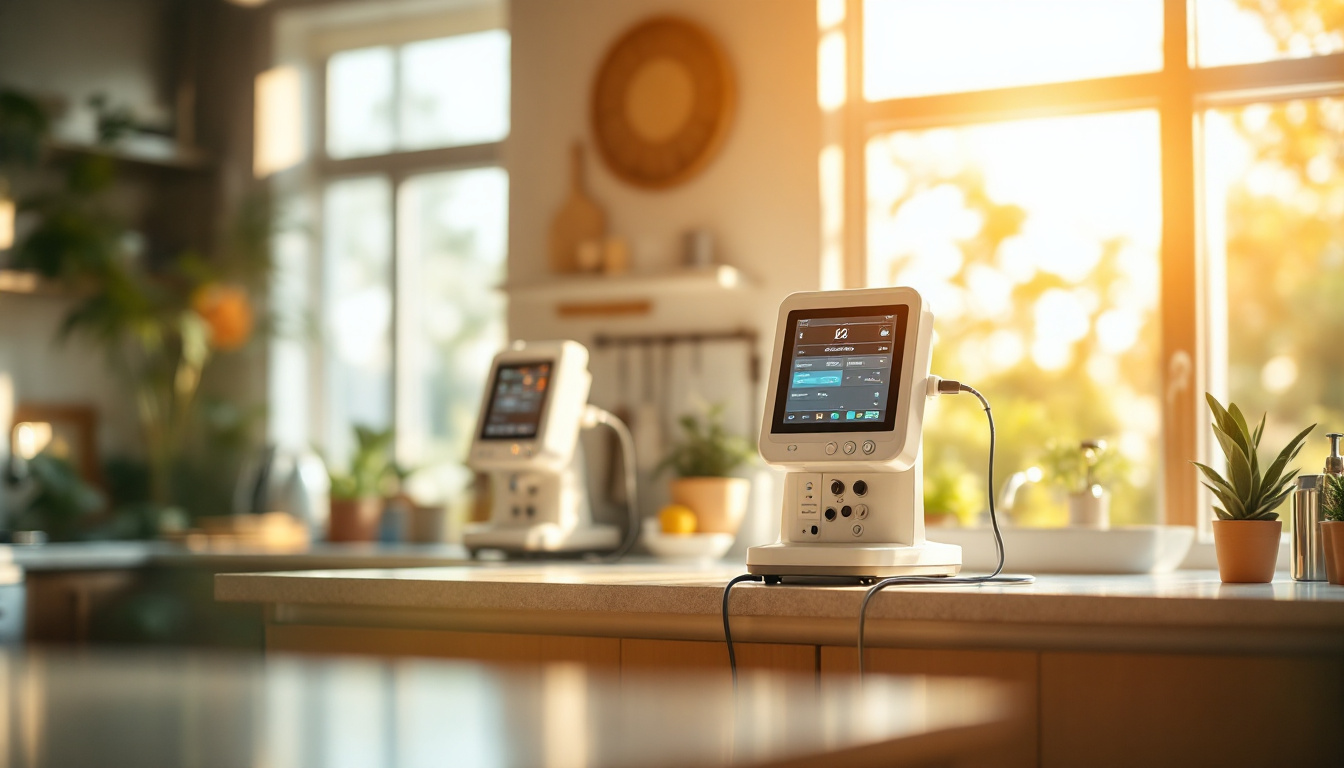How to Create a TPN-Friendly Lifestyle at Home

Creating a Harmonious Home for TPN Management
Adapting to a Total Parenteral Nutrition (TPN) regimen at home can be a complex journey that involves more than just medical adherence. It requires a well-thought-out approach to home organization, lifestyle adjustments, and environmental considerations. With a growing desire to lead eco-friendly lives, many are also looking to incorporate sustainable practices into TPN management. This guide will explore effective strategies to create a TPN-friendly lifestyle at home, balancing health needs with environmental responsibility.
Designing an Efficient Home Setup for TPN Administration

Organizing TPN Supplies Efficiently
Establishing an organized space for TPN supplies is crucial for effective home management. Use transparent containers to categorize and store items, making it easy to find needed supplies quickly. Consider implementing a mini fridge dedicated to TPN storage. This keeps the formula at the correct temperature and minimizes cross-contamination, which enhances safety.
Choosing the Right Furniture for TPN Administration
Selecting the appropriate furniture greatly simplifies the TPN administration process. A nightstand near your TPN setup can serve as a convenient storage and preparation area. This allows easy access to supplies during administration, helping to streamline the process, decrease anxiety, and ensure the treatment is done smoothly without unnecessary interruptions.
Minimizing Disorganization to Reduce Stress
A tidy living environment directly influences mental well-being. To foster a more relaxed atmosphere, develop clever storage solutions that prevent clutter. Regularly reassessing your organization methods helps maintain a clean space. Moreover, consider repurposing containers and using established storage units, reducing waste and contributing to a more sustainable household.
Adopting these approaches will help create a more efficient home setup for TPN administration, ensuring you're prepared for treatment while maintaining a balanced and serene living space.
Eco-Friendly Practices in TPN Management

What does an eco-friendly lifestyle mean and how can it be related to managing TPN needs?
An eco-friendly lifestyle focuses on making choices that mitigate environmental harm, including the use of renewable resources and reducing waste. This perspective is especially important for those managing Total Parenteral Nutrition (TPN), as these practices can enhance health while also being mindful of the planet.
Managing TPN in an environmentally friendly way can be approached in several ways:
Reducing Single-Use Plastics in TPN: By minimizing the use of disposable plastic items and opting for reusable instead, individuals can significantly decrease plastic waste. For instance, replacing plastic bags or containers with glass or silicone alternatives can contribute to a more sustainable TPN regimen.
Utilizing Recyclable Materials: Using recyclable materials not only helps reduce landfill waste but also encourages responsible consumption. Properly repurposing or recycling TPN-related packaging can save resources and reduce the carbon footprint associated with new product manufacturing.
Sourcing Ingredients Locally: Acquiring TPN supplies and ingredients from local or sustainable sources promotes environmental stewardship. Local sourcing reduces transportation emissions and supports community economies, which is beneficial from both a health and environmental perspective.
Additional Considerations
Practicing eco-friendly behaviors can extend beyond TPN management. Implementing solutions such as composting food waste or choosing biodegradable cleaning products enhances sustainability at home. Further, these changes can bolster personal well-being, making them worthwhile for those in need of specialized nutrition.
Incorporating these sustainable habits while managing TPN not only makes medical care more environmentally conscious but also fosters overall health and wellness.
Practical Tips for Refrigeration and Storage

Using a mini fridge for TPN storage
When managing TPN (Total Parenteral Nutrition) at home, choosing the right storage solutions is pivotal. A mini fridge can be an excellent investment. It provides better temperature control, ensuring the TPN formula remains at the appropriate temperature. This dedicated appliance helps keep nutrients stable and effective for your treatment.
Avoiding cross-contamination
Cross-contamination is a significant concern in TPN management. By utilizing a designated mini fridge, you can limit exposure to other food items, which could compromise the nutritional integrity of the TPN solution. Keeping everything in a separate space prevents accidental mixing and preserves the quality of your supplies.
Innovative storage solutions
Organization is crucial for managing TPN supplies effectively. Innovative storage solutions can encompass everything from clear bins for easy visibility to labeled containers that ensure you know exactly what you have on hand. A tidy storage area not only prevents chaos during stressful moments but also positively impacts your mental well-being, making the entire process smoother.
| Tip | Description | Benefits |
|---|---|---|
| Mini fridge | Use for better temperature control for TPN | Maintains nutrient stability |
| Avoid cross-contamination | Keep TPN supplies separate from food | Prevents accidental mixing |
| Innovative storage | Utilize bins and labeled containers for TPN supplies | Enhances organization and reduces stress |
Creating a Sustainable Home Environment

How can I adapt my home environment to be more eco-friendly while managing TPN?
To adapt your home environment to be more eco-friendly while managing TPN, there are several practical steps you can take. Consider implementing energy-saving measures like:
- Turning off devices when not in use.
- Utilizing energy-efficient appliances to reduce electricity consumption.
- Switching to 100% renewable electricity sources.
Minimizing waste is another vital aspect. Start by:
- Practicing composting to turn organic waste into fertilizer.
- Following local recycling guidelines to ensure materials are repurposed effectively.
- Reusing containers for storage instead of purchasing new items.
What dietary changes support sustainability at home?
Adopting a more plant-based diet can significantly lower your carbon footprint. This involves:
- Choosing to include vegetables and legumes as primary meal components.
- Reducing meat consumption, which can lead to a decrease in greenhouse gas emissions.
- Growing your own herbs or vegetables to further enhance sustainability and provide fresh ingredients for meals.
How do I improve my home's insulation for better energy efficiency?
Improving insulation is crucial for maintaining energy efficiency in your home. To achieve this, consider:
- Adding extra insulation to your home to minimize heat loss during winter.
- Switching to LED light bulbs, which consume less energy than traditional bulbs.
- Closing blinds during extreme temperatures to improve home insulation.
Table of Sustainable Practices for TPN Management
| Practice | Description | Benefits |
|---|---|---|
| Energy-saving measures | Use of efficient appliances and renewable energy | Reduced energy consumption and costs |
| Composting | Turning organic waste into fertilizer | Minimizes landfill waste |
| Plant-based diet | Incorporating more plant foods into meals | Lowers carbon footprint |
| Improving insulation | Enhancing home insulation with materials | Increased energy efficiency and comfort |
Embracing these strategies will not only support your TPN management but also foster a healthier, more sustainable home environment.
Managing TPN On-the-Go
Preparing for travel with TPN
Traveling while managing TPN (Total Parenteral Nutrition) can be a complex task, but with the right preparation, it is entirely feasible. It's essential to plan ahead by organizing all supplies needed for the journey. A checklist can help ensure nothing is forgotten, including TPN bags, IV supplies, and any medications.
Ensuring feasible treatment on the move
Setting up a travel-friendly TPN system involves ensuring accessibility to your supplies. Use compact and durable storage for your TPN essentials, allowing for easy transport. A reliable cooler can support temperature control, ensuring your nutrition remains stable during the trip.
Communication with healthcare teams
Effective communication with your healthcare team is crucial. Before traveling, speak with your doctor or nutritionist about your travel plans, as they can offer specific advice based on your health condition. Additionally, share your itinerary with them, detailing where you will be and when, to ensure continued care accessibility in case of emergencies.
By taking these steps into account, you can confidently manage TPN while enjoying mobility and flexibility.
Integrating Renewable and Energy-Efficient Practices
Switching to Solar Energy
Installing solar panels can seem like a large initial investment; however, the long-term benefits are substantial. With proper installation, homeowners can significantly reduce their carbon footprint and save on energy costs over time. Solar energy provides a renewable and sustainable power source, benefiting both the environment and the household's budget.
Using Smart Technology to Save Energy
Embracing smart technology in the home can lead to impressive energy savings. For instance, smart thermostats can adjust heating and cooling systems based on real-time weather conditions and occupancy, leading to savings of up to $180 annually just through this one device. Other smart devices can streamline energy use, allowing homeowners to monitor and manage their consumption effectively.
Replacing Traditional Bulbs with LEDs
Switching to LED light bulbs is a simple yet impactful way to enhance energy efficiency at home. LEDs require significantly less energy to produce the same brightness compared to traditional bulbs, contributing to lower electricity bills. Additionally, their longer lifespan means reduced waste as you won’t be replacing them as often. This small adjustment in lighting can reap substantial benefits over time.
Supporting Sustainable Diet Choices

What are some sustainable practices that can be integrated into daily life to support TPN needs?
Integrating sustainable practices into daily life is essential, especially for those managing TPN. Here are some practical suggestions:
Reducing Meat Consumption
Lowering meat intake can significantly cut down your carbon footprint. Consider incorporating more plant-based meals, which are not only healthier but also environmentally friendly.Opting for Regional and Seasonal Foods
Supporting local farmers by choosing regional and seasonal produce helps reduce transportation emissions. It also encourages a diet rich in fresh, nutritious foods that align with TPN nutritional requirements.Avoiding Food Waste through Planning
Meal planning can minimize food waste, which is crucial given that 30-40% of the U.S. food supply ends up in landfills. Efficient planning ensures you utilize all ingredients, supporting both your health needs and sustainability goals.Using Tap Water Instead of Bottled Water
Swapping bottled water for tap water helps cut down on single-use plastic, contributing to a healthier planet. Consider using a water filter if you seek improved taste or quality.Choosing Organic Products
Buying organic supports sustainable farming practices and reduces the use of harmful chemicals in food production. This decision benefits both personal health and ecological balance.Implementing Energy-Efficient Appliances
Using energy-efficient appliances in food storage and preparation can lead to substantial energy savings, further minimizing your environmental impact.
Through these sustainable practices, individuals on TPN can not only manage their health more effectively but also contribute positively to the environment.
Water and Waste Management for Eco-Conscious Living
Conserving Water Through Practical Tips
Managing water resources effectively is crucial for a sustainable home. Simple actions can significantly save water:
- Take Shorter Showers: Reduce the duration of your showers to decrease water usage.
- Use Watering Cans: Instead of hoses, use watering cans for gardens, allowing for precise application.
- Install a Rain Barrel: Collect rainwater for irrigation and other non-drinking uses, conserving municipal water.
Composting to Reduce Landfill Waste
Composting is a highly beneficial practice that transforms kitchen scraps into rich fertilizer. This process not only reduces landfill waste but also enriches garden soil. By turning organic waste into compost:
- Lower Carbon Footprint: Composting significantly reduces methane emissions from decomposing food in landfills.
- Save on Fertilizers: Homemade compost serves as a cost-effective and natural alternative to chemical fertilizers.
Recycling Effectively
Recycling plays an essential role in waste management. To recycle effectively, it’s necessary to understand local guidelines:
- Know What Can Be Recycled: Different areas have varying rules for recyclables; familiarize yourself with these to maximize participation.
- Reduce Contamination: Clean your recyclables to prevent contamination that could lead to entire batches being discarded.
Implementing these strategies can significantly contribute to a more sustainable household.
Embracing a Balanced and Sustainable Lifestyle
Creating a TPN-friendly home environment that also respects our planet involves a balanced fusion of practicality and sustainability. By orchestrating our daily lives with thoughtful organizational strategies and eco-friendly practices, we not only optimize our health outcomes but also contribute positively to the environment. As we strive to meet our nutritional needs through TPN, integrating these strategies allows us to live more sustainably, turning our homes into true sanctuaries of health and ecological mindfulness.
References
- Surviving to Thriving: Beginner's Guide to Living Well on Home TPN
- 7 Easy Steps to an Eco-Friendly Home | Green City Times
- 15 Ideas to Make a More Eco-Friendly Home - Biofriendly Planet
- Go Green: 10 Tips for a More Sustainable Lifestyle
- The Ultimate 20 step Guide to Eco-friendly Living | Good Energy
- Sustainable Living 101: Tips for a Greener Home
- 40 Ways to Be More Eco Friendly in 2025 | GreenMatch
- 12 Sustainable Practices You Can Do at Home - The Earthling Co.



































































































